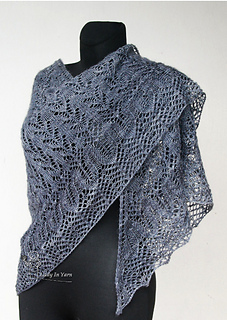patterns >  Lady in Yarn
Lady in Yarn
> Ears of Grain Shawl





















Ears of Grain Shawl
The pattern has been tested by English speaking knitters. Instructions were proofread. Written and charted instructions and photo tutorials included.
Suggested yarns: from lace to dk
Tools: 4 markers + 1 marker (you will work with 4 markers at a time, and the one additional marker is to make changing markers’ positions easier), 3.5 mm (US 4) needles
Gauge: 20 sts & 28 rows = 4x4 inches (10x10cm) in right/left panel’s lace after blocking.
Obtaining the given gauge is not crucial but differences will affect the finished size and the yardage needed.
Ears of Grain Shawl is worked in one piece from the top down. It starts at the center top and is worked down to the bottom edge. The body of the shawl is comprised of two triangles with a rectangular panel between them. The border is worked in the same direction as the body.
You may easily customize the size of the shawl by changing the number of repeats, working the shawl in a different yarn weight or needle size, or all of the above.
The Shawl is very intuitive and the work goes very fast.
Szal jest przetłumaczony na język polski, używa jednak skrótów angielskich w instrukcjach opisowych oraz diagramach. W planach jest całkowite przetłumaczenie wzoru - wraz z instrukcjami, jednakże, na razie taka wersja nie jest dostępna.
Zalecana grubość włóczki: lace - dk
Przybory: 4 markery + 1 marker (będziesz pracować cały czas z 4 markerami, a dodatkowy marker jest potrzebny tylko aby ułatwić zmianę pozycji markerów), druty 3,5 mm
Próbka rozliczeniowa: 20 oczek & 28 rzędów = 10x10cm (4x4 in) mierząc na prawym lub lewym panelu, po zblokowaniu. Próbka rozliczeniowa nie jest kluczowa.
Uzyskanie wymiarów podanych w próbce rozliczeniowej, nie jest istotne, ale różnice będą wpływać na wymiary chusty oraz zużycie włóczki.
Ears of Grain jest chustą dzierganą od góry do dołu. Dzierganie rozpoczyna się na górze chusty, na jej środku, dalej chusta jest wyrabiana w dół, aż do dolnego brzegu. Główna część szala składa się z dwóch trójkątów z prostokątnym panelem pomiędzy nimi. Bordiura chusty jest wyrabiana w tym samym kierunku jak jej główna część.
Wielkość szala można łatwo dostosować poprzez zmianę liczby powtórzeń głównej części lub wyrabianie chusty z grubszej/cieńszej włóczki lub na grubszych/cieńszych lub poprzez wszystkie wymienione wyżej możliwości.

13726 projects
stashed
17083 times
10049 projects
stashed
8446 times
135685 projects
stashed
149167 times
241 projects
stashed
146 times
118 projects
stashed
99 times
9240 projects
stashed
7588 times
319 projects
stashed
526 times
649 projects
stashed
734 times
380 projects
stashed
330 times
3890 projects
stashed
7300 times
225 projects
stashed
231 times
20 projects
stashed
25 times
209 projects
stashed
242 times
84 projects
stashed
125 times
9 projects
stashed
12 times
101 projects
stashed
90 times
- First published: August 2014
- Page created: August 11, 2014
- Last updated: September 12, 2024 …
- visits in the last 24 hours
- visitors right now





